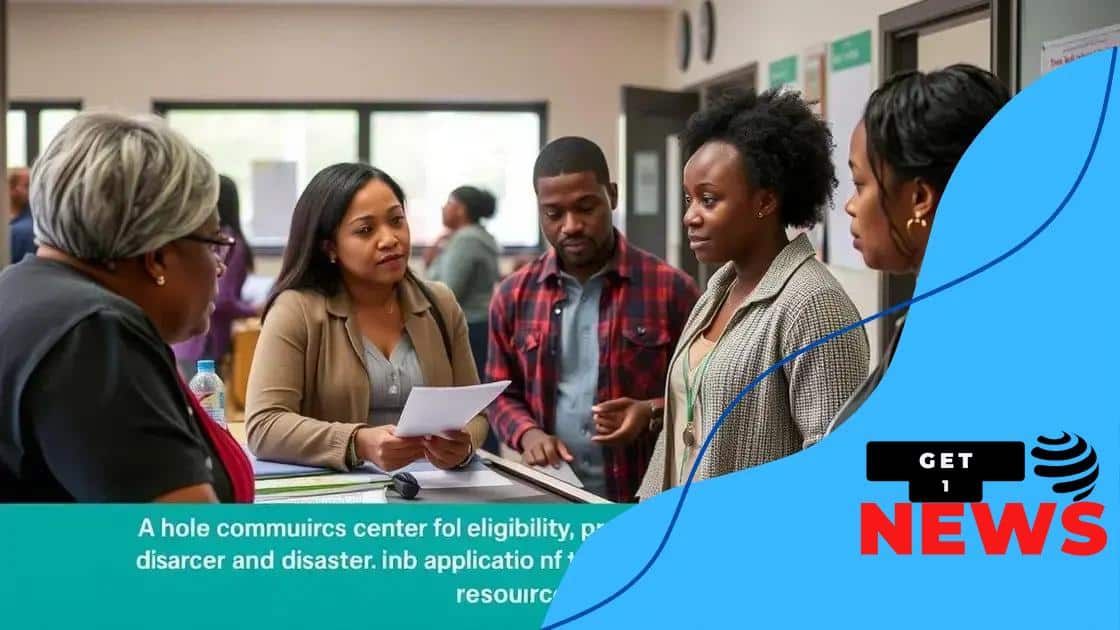Emergency financial aid for natural disasters: what to know

Emergency financial aid for natural disasters includes various types of assistance such as federal grants, community aid, and low-interest loans, aimed at supporting individuals and families in recovery efforts.
Emergency financial aid for natural disasters can be a lifesaver when unexpected crises strike. Have you ever wondered how to navigate these crucial resources when you need them the most?
Understanding emergency financial aid
Understanding emergency financial aid is crucial when disasters strike. This aid provides support to those affected by natural calamities, ensuring they have the means to recover. It’s important to grasp how these funds operate to make the most of them.
Types of Emergency Financial Aid
Emergency financial aid comes in various forms, each tailored to meet specific needs. Here are some common types you might encounter:
- Government grants: These funds do not need to be repaid and are often aimed at helping victims recover quickly.
- Loans: While these must be repaid, they offer much-needed resources for short-term financial relief.
- Insurance payouts: Home or renters insurance might cover certain disaster-related damages, providing additional support.
- Nonprofit assistance: Many nonprofits offer financial help during crises, ranging from direct cash assistance to the provision of essential supplies.
When seeking financial aid, understanding your options can empower you. Knowing who to turn to can significantly impact your recovery journey. Some people also benefit from local community programs that provide immediate relief. These initiatives often supplement government offerings, making them more accessible.
In addition to knowing the types of aid available, it’s vital to understand the process of application. Many programs require specific documentation to verify your losses. This could include damage assessments and proof of income loss, so having these records handy is beneficial.
Don’t hesitate to reach out for help when navigating these resources. Local community centers often have information on where to find aid, and they can guide you through the process.
Eligibility Criteria
Eligibility for aid can vary widely based on the program and your location. Generally, applicants must prove they have suffered damages due to a disaster. Each program will have different requirements, so reviewing them carefully is important.
- Residency: You often need to live in the affected area to qualify.
- Severity of damage: Funds may be allocated based on how serious your situation is.
- Income level: Some programs target low-income households, while others may assist anyone affected.
Understanding these criteria can better prepare you for the application process. Be ready to provide the necessary personal details to help assess your situation effectively. Knowing that you are not alone during times of crisis is vital, as many people face similar challenges.
In conclusion, the right knowledge can expedite your access to emergency funds and support your recovery. Understanding the types of programs available and the eligibility requirements is the first step towards reclaiming stability post-disaster.
Types of financial assistance available
When facing a disaster, knowing the types of financial assistance available can help significantly. Various programs are designed to support individuals and families during these challenging times.
Categories of Financial Assistance
Financial aid typically falls under a few key categories. Each serves a unique purpose to aid recovery:
- Federal disaster relief: This includes funds from FEMA and other federal agencies to assist with immediate recovery needs.
- State and local aid: Often provided by state agencies or local governments, these funds can help with housing and repairs.
- Private sector assistance: Banks and utilities may offer payment deferrals or specialized loans during emergencies.
- Charitable organizations: Many nonprofits provide direct aid, including food, shelter, and financial support for those in need.
Each category plays a vital role in helping affected individuals rebuild their lives. For example, charitable organizations may offer not just financial assistance but also essential services like counseling and rehabilitation.
Special Programs
In addition to general aid, there are special programs aimed at specific groups. Some of these include:
- Homeowner assistance programs: These programs help homeowners repair or replace damaged property.
- Rental assistance: Designed for those who lost their homes, rental assistance programs can provide funds for temporary housing.
- Small business aid: Many disasters affect local businesses greatly. Special funding is available to help them recover.
Understanding how these types of assistance work can empower you during a difficult crisis. Knowing where to look for help is half the battle. The application procedures may vary, but many programs allow you to access help quickly and efficiently.
It’s essential to keep track of all resources available to you, as they can significantly ease your recovery journey. Always remember that you have options and that reaching out for support can open many doors.
Eligibility criteria for aid programs

Understanding the eligibility criteria for aid programs is key to accessing financial support during a disaster. Each program has its own specific requirements, and knowing them can help streamline the application process.
Common Eligibility Requirements
Most aid programs have a few standard eligibility requirements that applicants must meet. These might include:
- Residing in affected areas: Typically, you must live in a region that has been designated as a disaster zone to qualify for assistance.
- Proof of damage: Applicants generally need to provide documentation showing the extent of damages incurred due to the disaster.
- Financial need: Some programs target low-income households or those who demonstrate financial hardship as a result of the disaster.
- Citizenship status: Many programs require applicants to be U.S. citizens or legal residents.
Having these documents ready can expedite your application. It’s wise to gather any proof of residence, income statements, and damage assessments before applying.
Additional Criteria
In addition to basic requirements, certain programs might have more specialized criteria. These can include :
- Type of assistance requested: Different types of aid (grants, loans) may have unique requirements.
- Household size: Some programs adjust assistance based on the number of people living in the household.
- Previous aid received: Eligibility might also depend on whether you have received aid from similar programs before.
Being aware of these extra criteria can help you better prepare your application. It helps to check with local agencies for specific details related to each program. Also, community resources such as local nonprofits can provide additional information on what to expect.
Understanding the eligibility criteria ensures you are prepared when disaster strikes. Equipping yourself with the right knowledge can make a significant difference in securing the assistance you need to recover.
How to apply for emergency funds
Knowing how to apply for emergency funds can make a significant difference in your recovery process after a disaster. Navigating the application process may seem overwhelming, but understanding the steps can simplify it.
Gather Required Documents
The first step in applying for emergency funds is gathering the necessary documents. Having these ready will speed up your application. Key documents may include:
- Proof of identity: Such as a government-issued ID or driver’s license.
- Proof of residence: Utility bills or lease agreements can help confirm where you live.
- Damage assessment: Records showing the extent of the damages caused by the disaster.
- Financial information: This might include income statements, tax returns, or bank statements.
Collecting these documents ahead of time provides a clearer picture of your situation and helps ensure you meet all application requirements.
Choose the Right Program
It’s important to determine which emergency aid program suits your needs best. Research available funds through government websites or local organizations. Each program may have different criteria and benefits, so consider:
- Type of aid offered: Different programs provide unique assistance options, such as grants or loans.
- Application deadlines: Some programs may have strict deadlines, making it important to act quickly.
- Additional support services: Some organizations offer extra help like counseling or legal support.
Knowing your options allows you to select the most suitable program for your circumstances. It’s helpful to visit community centers or contact local agencies to get accurate information.
Once you’ve gathered your documents and chosen a program, the next step is to complete the application forms. Be thorough and honest when providing information. Mistakes or omissions can delay your application or even lead to rejection.
After submitting your application, stay proactive. Follow up with the organization to check the progress. This ensures you remain informed about your application status.
Managing funds during recovery
After receiving emergency funds, managing these resources wisely is vital for recovery after a disaster. Knowing how to allocate funds can significantly affect your financial stability.
Creating a Budget
Establishing a budget is an excellent first step in managing your funds. A budget allows you to track your expenses and ensure you spend within your means. Here are some key steps to create an effective budget:
- List essential expenses: Identify your immediate needs, like food, shelter, and medical care.
- Prioritize repayments: If you have debts, consider setting aside funds for repayments to prevent further issues.
- Plan for future costs: Apart from immediate expenses, think about upcoming bills or repairs that may arise.
Regularly reviewing and adjusting your budget helps you stay on track as your situation evolves. This is critical during the uncertain time following a disaster.
Tracking Your Expenses
Keeping track of all your spending is crucial. It provides insight into where your funds are going and helps identify areas to cut back. You can track expenses using:
- Spreadsheets: Simple and effective, spreadsheets allow you to categorize and calculate your total spending.
- Mobile apps: Numerous budgeting apps can help monitor and manage finances on the go.
- Pencil and paper: Some people prefer the traditional method of jotting down expenses.
Whichever method you choose, consistency is key. Regularly updating your records can help you make informed decisions.
It’s also wise to set aside a portion of your funds as an emergency reserve. This backup can provide peace of mind for unplanned expenses that may arise during your recovery.
Networking with community resources may also open opportunities for financial counseling. Many nonprofits offer services to help understand your finances better and develop sound strategies for spending your assistance funds.
FAQ – Frequently Asked Questions about Emergency Financial Aid
What types of financial aid are available after a disaster?
Various types include federal disaster relief, state and local aid, charitable organization assistance, and low-interest loans.
How can I apply for emergency financial aid?
To apply, gather necessary documents, choose the right program, fill out the application forms carefully, and submit them promptly.
What documents do I need for the application?
Common documents include proof of identity, proof of residence, damage assessments, and financial information.
How should I manage the funds I receive?
Creating a budget, tracking expenses, and setting aside emergency reserves are key to effective fund management during recovery.





